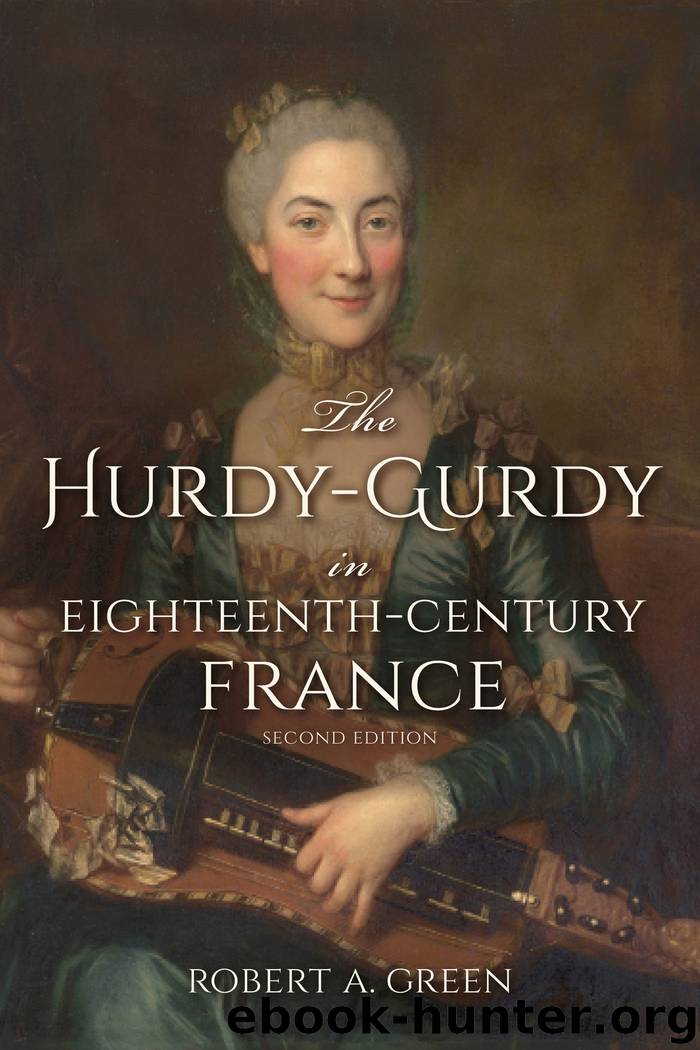The Hurdy-Gurdy in Eighteenth-Century France by Robert A. Green

Author:Robert A. Green
Language: eng
Format: epub
Publisher: Indiana University Press
Published: 2016-02-27T16:00:00+00:00
DYNAMICS
The vielle is capable of playing both loud (fort) and soft (doux), and these “terrace dynamics” are often found in the music. The difference between these two levels of sound is achieved by the contrast between articulated playing (created by the coup de poignet described below) and playing with a smooth turning of the wheel, named by Boüin en musette for its resemblance to the sound of that instrument.14 When playing en musette, limited gradations and swells (enflés) are possible, resulting in an expressive, singing style.15
Some movements are played entirely en musette. Boüin characterizes them in the following way: “In tender airs, or musettes, there is no prescribed coup de poignet. One can turn the wheel more or less quickly according to the character of the airs.”16 The suites of Michon often contain paired dance movements where the second dance is marked doux, indicating that it should be played without coup de poignet. This practice was standard even where it was not indicated. The Ballard method says, “it should be observed that ordinarily, when two menuets are played, and one is in major and the other minor, the first which is in major is played detaching all the notes with the poignet, and the other, which is in minor, is played en musette, that is to say softly turning always equally.”17
Most often, directions for dynamics in the music reveal, as one might expect, the introduction of contrast between sections or phrases. They also reveal the necessity of creating balance within the ensemble, such as when the vielle must move into the background and other parts must come to the fore. Dupuits summarizes the possibilities of using this type of contrast within a piece:
1. Where the melody is repeated.
2. Where the melody is less active (i.e., more lyrical).
3. Where the bass has an active part.
4. Near (just before) a passage which one wishes to make stand out.18
He also provides us with a musical example illustrating the effective use of contrast (see example 3.3).
Download
This site does not store any files on its server. We only index and link to content provided by other sites. Please contact the content providers to delete copyright contents if any and email us, we'll remove relevant links or contents immediately.
| Biographies | Business |
| History & Criticism | Instruments |
| Musical Genres | Recording & Sound |
| Reference | Songbooks |
| Theory, Composition & Performance |
The Goal (Off-Campus #4) by Elle Kennedy(13540)
Kathy Andrews Collection by Kathy Andrews(11726)
Diary of a Player by Brad Paisley(7487)
What Does This Button Do? by Bruce Dickinson(6133)
Assassin’s Fate by Robin Hobb(6123)
Big Little Lies by Liane Moriarty(5697)
Altered Sensations by David Pantalony(5043)
Pale Blue Dot by Carl Sagan(4906)
Sticky Fingers by Joe Hagan(4100)
The Death of the Heart by Elizabeth Bowen(3550)
The Heroin Diaries by Nikki Sixx(3492)
Beneath These Shadows by Meghan March(3261)
Confessions of a Video Vixen by Karrine Steffans(3240)
How Music Works by David Byrne(3182)
The Help by Kathryn Stockett(3082)
Jam by Jam (epub)(3019)
Harry Potter 4 - Harry Potter and The Goblet of Fire by J.K.Rowling(2984)
Strange Fascination: David Bowie: The Definitive Story by David Buckley(2797)
Petty: The Biography by Warren Zanes(2696)
